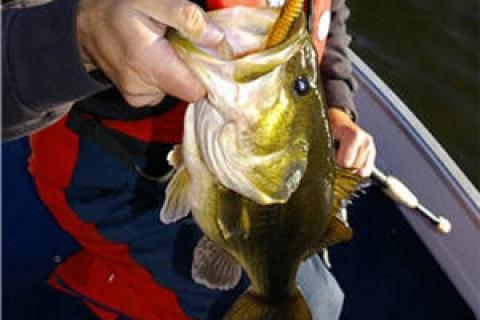
Fishing the late fall shift on northern lakes has its advantages. Largemouth bass can be relatively easy to locate and, for the most part, will be the largest you will find them all season long.
 |
|
Put that sonar imaging fish finder to work this fall to locate largemouths. Then, work your lure slowly and you, too, can end up catching some nice ones. |
Here are some tips to ensure your season winds down with some solid action.
Seek Out Transition Zones
Notwithstanding the certainty of a cold chill in the air, October and November are two months that are predisposed for hot action. Fish can be plentiful - if you know where to look.
Transition zones, although productive throughout the year, are especially enticing for fish once the fall chill sets in. Rock plays a big part in that. Seek out mid- to deep-water areas holding isolated boulders, adjacent to sand or vegetation. Many times largemouth will hold over this hard substrate; picking off wayward crustaceans or bait fish.
Sonar is an imperative asset for locating these mid-lake gems. If you have down scan or structure scan on your fish finder, it will be worth its weight in gold.
Slow Down
Although fish are putting on the feed bag at this time of year, they are less likely to exert an undue amount of effort to bulk up. Vertical baits, such as flipping jigs, creature baits on football heads, and tubes allow you to methodically work structure while staying in the strike zone of a fish the longest. They also replicate the movements and action of their prey. You can never work a bait too slow in the late fall. It can be a game of inches, and patience is definitely required.
Scent Things Up
Although my baits get a good dousing of fish attracting scent all season long, once the water turns frigid it is even more imperative. If your baits smell and taste real, the likelihood of largemouths striking and holding on goes up exponentially. Be liberal with the spray and watch your catch rate rise.
Waypoint Your Hot Spots
Whether with mapping software on your phone, or better still, with a GPS-enabled sonar, tracking your waypoints during the cold fall months equates to smart fishing. At this time of year, fish will relate to specific structure areas. They also don't move a lot. Having the ability to return, either a few hours or a few days later, to the same spots will bring about consistent action.
Know When to Throw in the Towel
Over the years I have discovered one thing about fall bass fishing - once water temperatures reach 40 degrees F, it can be a definite struggle to catch fish. My favorite temperatures range between 45 and 60 degrees F. Once they red line out at 40, I turn my attention to other outdoor pursuits.
For more great tips on best fall bass fishing lures, visit Cold Water Bass Lures at Bass Pro Shops 1Source.
- 20070 views

